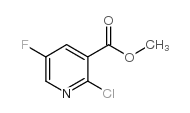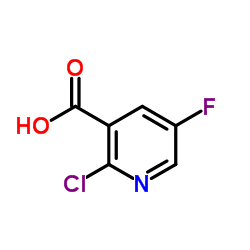847729-27-5
| Name | methyl 2-chloro-5-fluoropyridine-3-carboxylate |
|---|---|
| Synonyms |
Methyl2-chloro-5-fluoronicotinate
2-chloro-5-fluoronicotinic acid methyl ester 2-chloro-5-fluoro-3-pyridinecarboxylic acid methyl ester |
| Density | 1.386g/cm3 |
|---|---|
| Boiling Point | 235.4ºC at 760 mmHg |
| Molecular Formula | C7H5ClFNO2 |
| Molecular Weight | 189.57200 |
| Flash Point | 96.2ºC |
| Exact Mass | 188.99900 |
| PSA | 39.19000 |
| LogP | 1.66070 |
| Index of Refraction | 1.511 |
|
SECTION 1: Identification of the substance/mixture and of the company/undertaking Product identifiers Product name: Methyl 2-Chloro-5-Fluoronicotinate : ADE000416 REACH No.: A registration number is not available for this substance as the substance or its uses are exempted from registration, the annual tonnage does not require a registration or the registration is envisaged for a later
registration deadline. SECTION 2: Hazards identification Classification of the substance or mixture Not a hazardous substance or mixture according to Regulation (EC) No. 1272/2008. Classification according to EU Directives 67/548/EEC or 1999/45/EC Xn HarmfulR22 For the full text of the R-phrases mentioned in this Section, see Section 16. Label elements Other hazards This substance/mixture contains no components considered to be either persistent, bioaccumulative and toxic (PBT), or very persistent and very bioaccumulative (vPvB) at levels of 0.1% or higher. SECTION 3: Composition/information on ingredients Substances Molecular weight: 189,58 g/mol Hazardous ingredients according to Regulation (EC) No 1272/2008 ComponentClassificationConcentration Methyl 2-Chloro-5-Fluoronicotinate <= 100 % Hazardous ingredients according to Directive 1999/45/EC ComponentClassificationConcentration Methyl 2-Chloro-5-Fluoronicotinate Xn, R22<= 100 % SECTION 4: First aid measures Description of first aid measures General advice Consult a physician. Show this safety data sheet to the doctor in attendance. If inhaled If breathed in, move person into fresh air. If not breathing, give artificial respiration. Consult a physician. In case of skin contact Wash off with soap and plenty of water. Consult a physician. In case of eye contact Flush eyes with water as a precaution. If swallowed Never give anything by mouth to an unconscious person. Rinse mouth with water. Consult a physician. Most important symptoms and effects, both acute and delayed The most important known symptoms and effects are described in the labelling (see section 2.2) and/or in section 11 Indication of any immediate medical attention and special treatment needed No data available SECTION 5: Firefighting measures Extinguishing media Suitable extinguishing media Use water spray, alcohol-resistant foam, dry chemical or carbon dioxide. Special hazards arising from the substance or mixture Nature of decomposition products not known. Advice for firefighters Wear self-contained breathing apparatus for firefighting if necessary. Further information No data available SECTION 6: Accidental release measures Personal precautions, protective equipment and emergency procedures Use personal protective equipment. Avoid dust formation. Avoid breathing vapours, mist or gas. Avoid breathing dust. For personal protection see section 8. Environmental precautions Do not let product enter drains. Methods and materials for containment and cleaning up Pick up and arrange disposal without creating dust. Sweep up and shovel. Keep in suitable, closed containers for disposal. Reference to other sections For disposal see section 13. SECTION 7: Handling and storage Precautions for safe handling Avoid formation of dust and aerosols. Provide appropriate exhaust ventilation at places where dust is formed. For precautions see section 2.2. Conditions for safe storage, including any incompatibilities Store in cool place. Keep container tightly closed in a dry and well-ventilated place. Storage class (TRGS 510): Non Combustible Solids Specific end use(s) Apart from the uses mentioned in section 1.2 no other specific uses are stipulated SECTION 8: Exposure controls/personal protection Control parameters Components with workplace control parameters Exposure controls Appropriate engineering controls Handle in accordance with good industrial hygiene and safety practice. Wash hands before breaks and at the end of workday. Personal protective equipment Eye/face protection Use equipment for eye protection tested and approved under appropriate government standards such as NIOSH (US) or EN 166(EU). Skin protection Handle with gloves. Gloves must be inspected prior to use. Use proper glove removal technique (without touching glove's outer surface) to avoid skin contact with this product. Dispose of contaminated gloves after use in accordance with applicable laws and good laboratory practices. Wash and dry hands. The selected protective gloves have to satisfy the specifications of EU Directive 89/686/EEC and the standard EN 374 derived from it. Body Protection Choose body protection in relation to its type, to the concentration and amount of dangerous substances, and to the specific work-place., The type of protective equipment must be selected according to the concentration and amount of the dangerous substance at the specific workplace. Respiratory protection Respiratory protection is not required. Where protection from nuisance levels of dusts are desired, use type N95 (US) or type P1 (EN 143) dust masks. Use respirators and components tested and approved under appropriate government standards such as NIOSH (US) or CEN (EU). Control of environmental exposure Do not let product enter drains. SECTION 9: Physical and chemical properties Information on basic physical and chemical properties a) AppearanceForm: solid b) OdourNo data available c) Odour ThresholdNo data available d) pHNo data available e) Melting point/freezingNo data available point f) Initial boiling point and No data available boiling range g) Flash pointNo data available h) Evaporation rateNo data available i) Flammability (solid, gas) No data available j) Upper/lowerNo data available flammability or explosive limits k) Vapour pressureNo data available l) Vapour densityNo data available m) Relative densityNo data available n) Water solubilityNo data available o) Partition coefficient: n- No data available octanol/water p) Auto-ignitionNo data available temperature q) DecompositionNo data available temperature r) ViscosityNo data available s) Explosive propertiesNo data available t) Oxidizing propertiesNo data available Other safety information No data available SECTION 10: Stability and reactivity Reactivity No data available Chemical stability Stable under recommended storage conditions. Possibility of hazardous reactions No data available Conditions to avoid No data available Incompatible materials No data available Hazardous decomposition products In the event of fire: see section 5 SECTION 11: Toxicological information Information on toxicological effects Acute toxicity No data available Skin corrosion/irritation No data available Serious eye damage/eye irritation No data available Respiratory or skin sensitisation No data available Germ cell mutagenicity No data available Carcinogenicity IARC:No component of this product present at levels greater than or equal to 0.1% is identified as probable, possible or confirmed human carcinogen by IARC. Reproductive toxicity No data available Specific target organ toxicity - single exposure No data available Specific target organ toxicity - repeated exposure No data available Aspiration hazard No data available Additional Information RTECS: Not available SECTION 12: Ecological information Toxicity No data available Persistence and degradability No data available Bioaccumulative potential No data available Mobility in soil No data available Results of PBT and vPvB assessment This substance/mixture contains no components considered to be either persistent, bioaccumulative and toxic (PBT), or very persistent and very bioaccumulative (vPvB) at levels of 0.1% or higher. Other adverse effects No data available SECTION 13: Disposal considerations Waste treatment methods Product Offer surplus and non-recyclable solutions to a licensed disposal company. Dissolve or mix the material with a combustible solvent and burn in a chemical incinerator equipped with an afterburner and scrubber. Contaminated packaging Dispose of as unused product. SECTION 14: Transport information UN number ADR/RID: -IMDG: -IATA: - UN proper shipping name ADR/RID: Not dangerous goods IMDG: Not dangerous goods IATA:Not dangerous goods Transport hazard class(es) ADR/RID: -IMDG: -IATA: - Packaging group ADR/RID: -IMDG: -IATA: - Environmental hazards ADR/RID: noIMDG Marine pollutant: noIATA: no Special precautions for user No data available SECTION 15: Regulatory information This safety datasheet complies with the requirements of Regulation (EC) No. 1907/2006. Safety, health and environmental regulations/legislation specific for the substance or mixture No data available Chemical Safety Assessment SECTION 16 - ADDITIONAL INFORMATION N/A |
| Hazard Codes | Xi: Irritant; |
|---|---|
| RIDADR | NONH for all modes of transport |
| HS Code | 2933399090 |
|
~% 
847729-27-5 |
| Literature: WO2008/76425 A1, ; Page/Page column 82 ; WO 2008/076425 A1 |
|
~69% 
847729-27-5 |
| Literature: PFIZER INC.; PFIZER JAPAN, INC. Patent: WO2005/21508 A1, 2005 ; Location in patent: Page/Page column 97 ; WO 2005/021508 A1 |
|
~24% 
847729-27-5 |
| Literature: PFIZER PRODUCTS INC. Patent: WO2005/102389 A2, 2005 ; Location in patent: Page/Page column 200 ; WO 2005/102389 A2 |
| Precursor 4 | |
|---|---|
| DownStream 1 | |
| HS Code | 2933399090 |
|---|---|
| Summary | 2933399090. other compounds containing an unfused pyridine ring (whether or not hydrogenated) in the structure. VAT:17.0%. Tax rebate rate:13.0%. . MFN tariff:6.5%. General tariff:20.0% |





